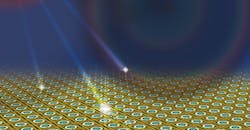Photon-counting camera has megapixel SPAD array for single-photon TOF and other imaging
Researchers at the Advanced Quantum Architecture Laboratory (AQUALab) at École polytechnique fédérale de Lausanne (EPFL; Lausanne, Switzerland) have developed the first megapixel photon-counting camera based on new-generation image-sensor technology that uses single-photon avalanche diodes (SPADs).1 The new camera can detect single photons of light at unprecedented rates, a capability that could advance applications that require fast acquisition of 3D images such as augmented reality and lidar systems for autonomous vehicles.
The researchers created one of the smallest SPAD pixels ever devised and reduced the power consumption of each pixel to less than 1 μW while maintaining speed and timing precision. The new camera can acquire images at up to 24,000 frames per second (fps).
SPADs are extremely efficient at detecting single photons and converting them into electrical signals that are stored in a digital memory. A large-format camera can be created by building an array of pixels that each contain a SPAD.
In the new work, the researchers drew on 15 years of SPAD research at the AQUALab in EPFL to create an extremely fast, high-resolution camera that leverages SPAD technology for advanced imaging. The new camera detects single photons and converts them into electrical signals at a record rate of about 150 MHz. Each SPAD sensor can be finely controlled to allow light in for as little as 3.8 ns. This quick “shutter speed” can capture extremely fast motion or be used to increase the dynamic range of an acquired image.
The researchers created extremely small SPAD pixels with a pitch of 9.4 μm and designed for low power consumption by using a feedback mechanism that almost immediately quenches the electron avalanche triggered by photon detection. This improves the overall performance and reliability of the pixels. They also used enhanced layout techniques to pack the SPAD sensors tighter, thus upping the detection area density and enabling a camera with a million pixels.
Sophisticated integrated-circuit-design techniques were applied to create an extremely uniform distribution of fast electrical signals over the large-scale pixel array. They showed that the shutter speeds varied by only 3% over the million pixels, demonstrating that this sensor could feasibly be made using available mass-production techniques. The maximum photon detection probability of the sensor was 27% and the median dark-count rate was 2 counts/s.
The researchers used the new camera to determine the time of flight (ToF) of photons emitted from a laser source and reflected by a target. They also captured complex scenes that are difficult for other imaging techniques to measure, such as an object viewed through a partially transparent window, and they used the camera to acquire conventional pictures with unprecedented dynamic ranges. In the future they plan to further improve the performance and timing resolution of the camera and to further miniaturize the components to make it more practical for a variety of applications.
Projected use in virtual reality and lidar
“Thanks to its high resolution and ability to measure depth, this new camera could make virtual reality more realistic and let you interact with augmented reality information in a more seamless manner,” says Edoardo Charbon from the Advanced Quantum Architecture Laboratory (AQUALab) at EPFL. Charbon developed the idea for the new camera and is the founder and head of AQUALab, where the image sensor was designed.
“For transportation applications, this new camera could help achieve unprecedented levels of autonomy and safety by enabling multiple low-power lidar devices to be used on a vehicle, providing fast, high-resolution 3D view of the surroundings,” says Kazuhiro Morimoto from Canon in Japan. “In a somewhat more distant future, quantum communication, sensing, and computing could all benefit from photon-counting cameras with multi-megapixel resolution.”
Source: https://www.osa.org/en-us/about_osa/newsroom/news_releases/2020/new_photon-counting_camera_captures_3d_images_with/
REFERENCE
1. K. Morimoto et al., Optica, 7, 4, 346-354 (2020); doi: https://doi.org/10.1364/OPTICA.386574.
About the Author
John Wallace
Senior Technical Editor (1998-2022)
John Wallace was with Laser Focus World for nearly 25 years, retiring in late June 2022. He obtained a bachelor's degree in mechanical engineering and physics at Rutgers University and a master's in optical engineering at the University of Rochester. Before becoming an editor, John worked as an engineer at RCA, Exxon, Eastman Kodak, and GCA Corporation.

